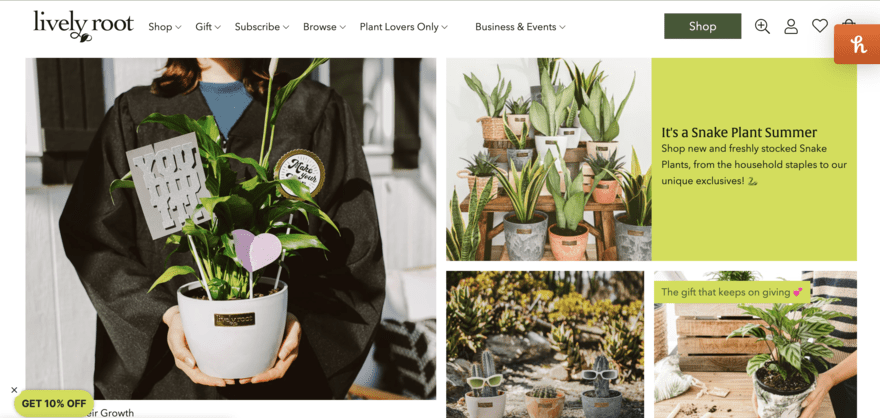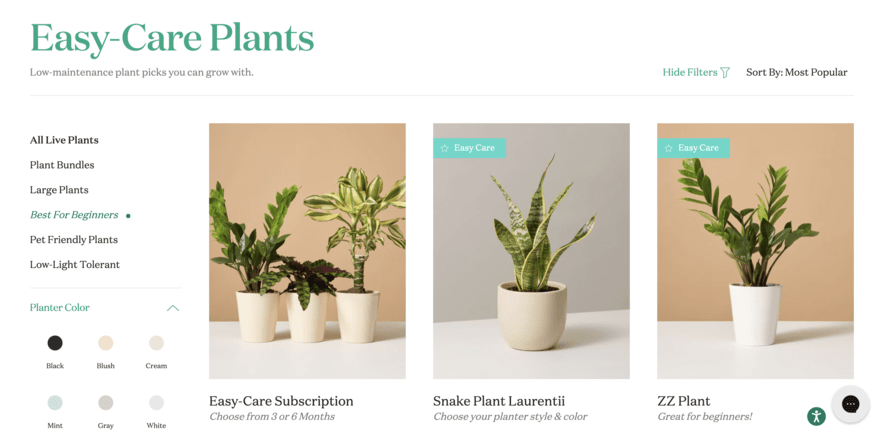How to Sell Plants Online: 9 Steps to Green, Leafy Success
If you click to purchase a product or service based on our independent recommendations and impartial reviews, we may receive a commission. Learn more
Growing and tending to plants is one of life’s greatest pleasures. Whether you love adding a colorful background to your living space, or tending to the flowerbeds in your garden, plants have the power to take away our stress.
If you love plants, you may decide that helping others with their plant projects is right up your street. And, if this is the case, you’ll be pleased to know that starting an online plant shop can be a fulfilling and profitable venture. In fact, it’s estimated that the US plant and flower growing industry alone is worth around $15.6 billion.
Worry not – in this guide, we’re going to walk you, step-by-step, through everything you need to know about selling plants online. We’ll take you through every option for how to sell online including our top choices, Shopify and Wix.
Our research has shown Shopify would be great for those selling plants online because it has a great inventory and sales features – ideal for larger plant stores. But Wix has similarly wonderful features and is super beginner-friendly with an impressive ease of use score.
Let’s get started!
#1 Research the Market
Before you dive into buying your stock, you will want to spend some time getting familiar with the market. This will help you make better informed decisions at every step of the journey.
Start by researching which plants are currently popular and in demand. This can be done by conducting simple Google searches, browsing plant forums, and using tools such as Google Trends. Ultimately this research will help you source plants which will be easy to sell.
You will also want to take some time to do market research and evaluate the competition. Again, this can be achieved by doing a simple Google search using terms which are relevant to the plant niche you are investing in. Look at how your competition presents themselves, who they target and how they price their products. This will help you develop a competitive strategy.
Finally, take the time to research any state, regional, national, or international industry regulations which may apply to your business. This will help you get to grips with what you will need to do before you can start selling plants online.
#2. Source Your Plants
While the opportunity that online plant selling presents is huge, knowing where to start your online store can be tricky. You can’t sell plants until you have plants to sell. So, the natural first step in setting up your online plant business is sourcing the right plants for your store.
There are a few things to consider at this stage:
- Which plants will you be selling, and who can supply them?
- How much to buy your plants for?
- How reliable do you need your supplier to be?
- How much time and resource do you want to put into growing/maintaining plants yourself?
Additional plant sourcing consideration…
Plant diversity can help you appeal to a wider audience. It can also help smooth out seasonal peaks and troughs, making plant selling a year-round profitable business. However, it can also make running your business more complex and sourcing products more tricky. Take time to consider how and if you want to offer a diverse range of plants.
Plant buyers tend to be conscious of the environmental impact of the products they buy. So, ensuring that you are sustainably sourcing your plants can help ensure you remain attractive to buyer.
Here are some plant supply options to consider, to get you started:
Grow Your Own
Growing your own plants to sell is a great option if you want to maintain a high level of control over your supply. It also allows you to grow what you know your customers want to buy, and limit the extra cost and confusion of working with multiple suppliers to meet demand.
If you do decide to grow your own plants, you’ll need to ensure that you properly cost up the equipment and time investment required. It can often be cheaper to buy from a wholesaler or a local nursery, as they can grow plants at a much cheaper cost.
Growing your own is also a good option if you plan on targeting the more expensive end of the market, as you can personally communicate the origin story of each plant, and demonstrate the love and attention that has gone into growing them.
Partner with a Wholesaler
Working with a plant wholesaler – such as Gro ‘n Sell – is a great option, especially if you want easy access to a large number of plants at a competitive price.
However, unlike when you grow your own plants, you’ll only be able to sell the plants that the wholesaler has available at any one time – limiting what your online store is able to offer, and restricting your ability to meet customer demands.
Work with a Local Nursery
Working with a local nursery can offer a mix of benefits. For example, they will often have a good supply of plants that can be purchased at a competitive price, helping you make more profit from each sale. If you regularly buy plants from them, you would also likely be able to influence what they grow, helping you better meet customer demand, without the need to invest in the equipment needed to grow your own.
#3. Decide Where to Sell Your Plants Online
There are several options available to you when you decide to sell plants online:
- Building your own ecommerce store
- Online marketplaces
- Social selling platforms
Building Your Own Ecommerce Store
The most established way to sell anything online is by setting up your store on trusted and easy-to-use platforms such as Shopify. Utilizing these platforms allows you to maintain a good level of control over your brand and sales.
The ongoing fees associated with making sales are often lower on these platforms than with other options, such as online marketplaces. However, it’s important to remember that building your own ecommerce store often requires an upfront cost to set the website up, and ongoing marketing to keep driving traffic to it.
If you’re not sure which online store builder is best for you, these are our recommendations:
- For a blend of fantastic features and ease of use, try Wix
- For help growing your plant store, try Shopify
| Wix | Shopify |
| Overall rating 4.8 | Overall rating 4.8 |
| Starting Price | Starting Price $29 |
| Visit Wix | Visit Shopify |
Further information:
Online Marketplaces
Online marketplaces such as eBay and Etsy offer an alternative way of selling your plants online. These platforms can be a great option when you get started, as they come with ready-made audiences, and will essentially promote and market your store for you.
When you sell via an online marketplace, they typically have high fees, making it more difficult to make a profit on your plants. Many businesses with an online store will also use these marketplaces to help them reach new audiences, but typically not as their sole ecommerce channel.
Social Media
Social media platforms such as Facebook and Instagram can be a great way to reach your audience in a place where they’re already spending a lot of their time.
Selling on social media is especially beneficial for brands that have already developed a strong presence across these platforms, through helping them to leverage the attention they have already earned there, and turn it into profit. This is now much easier with many social platforms (Facebook, Instagram & Pinterest) facilitating in-app purchases.
#4. Showcase Your Plants

Whether you sell via your own ecommerce store, an online marketplace, or social media, making your plants look and sound great will help you grab attention and make more sales.
Here are a few tips for how to showcase your plants online:
Product Photos
Your product photos are crucial to grabbing your audience’s attention. This is especially true with items that are colorful and aesthetically pleasing, such as plants!
Your main photos should focus on showing off your plants with no distractions. This means using good lighting, photographing the full plant, and using a white background. You can also use other photos or settings to show how your plants might look once the customer has taken them home.
One smart way to further engage page visitors is to include customer photos. This can help show potential purchasers exactly what your plants may look like in a real life setting.
Product Descriptions
Product descriptions are your opportunity to really sell your plants. Although you’ll need to use your descriptions to give key details such as plant size and care instructions, you should also seize this opportunity to inspire your customers, and help them understand how they might feel once the plant is in their home or garden.
Categorize Your Plants
Using categories can make it easier for customers to find exactly what they are looking for. Try adding as many helpful categories as possible. This may include plant type, care requirements, size, color, and style.
Add a Virtual Tour
A video or virtual tour of your plant can really help bring it to life. This type of content is especially important for brands that sell primarily online since it helps customers get a better idea of the look/dimensions/shape of specific plants.
#5. Price Your Plants Fairly
Pricing is a crucial part of marketing. Price your plants too high, and you’ll struggle to sell them. Price them too low, and you won’t make a profit!
When you price your plants, consider these factors:
- What do other businesses in the market sell the same (or similar) plants for?
- What are people willing to pay for the plants you sell?
- How much do the plants cost you to buy or grow? Including the cost of acquiring the plants, pots, soil, fertilizer, and any other supplies necessary for growing and selling the plants.
- How much does your business cost to run (website, marketing, etc.)?
- How much time do you invest in your business?
- What is the market demand for the plant?
- How rare is the plant?
- How large/mature is the plant?
- How much does packaging and shipping the plant cost?
#6. Set Up Your Online Plant Business
Depending on which selling platform you decide to use, there are different steps you need to take before you can start to sell plants online. Below, we outline what you might be expected to do in order to get selling online.
Online Store
It’s super simple to get started building your online store. If you decide to go with Shopify has a respectable score of 3.5/5 and BigCommerce 3.3/5.

The reason Wix is the easiest is that it has a drag and drop interface. This means that you can move and snap your page elements easily wherever you like – giving you creative freedom for your plant store.
If you’re looking for an ecommerce builder that can help your business expand into a large business, then Shopify or BigCommerce might be better for you. This is because they have larger inventory management and multichannel integration – helping your plant store sell more across different channels!
To get started with any of them:
- Visit the website of your chosen ecommerce platform and sign up
- Select a domain name for your store
- Select a theme for your store and customize it to mirror your brand
- Upload your products
- Decide which payment options you’ll offer your customers
- Go live, and start selling!
Further information:
Marketplace
- Visit the marketplace website you have chosen and create an account
- Set up your store and upload your products
- Input the required details (e.g. store name, preferences, payment info)
- Start selling!
Social Media
- Head to the social platform you wish to sell on
- Create an account (this may need to be a business account)
- Upload your products and submit them for approval
- Start selling via your social channels – good luck!
Further information:
#7. Package and Ship Your Plants
How you will package and ship your plants is easy to overlook. However, shipping and packaging fees can make up a big part of your overall costs, so this should be carefully considered. Ask yourself:
- How will you package your plants?
- Do you want to drop off your plants, or have orders picked up by a courier?
- How fast do you want to ship your items to customers?
- Which couriers meet your needs?
- How will you charge customers for shipping?
Here is a simple checklist to cover then shipping your plant products:
- Choose a plant safe packing material which will protect your plants during transit
- Ensure your plants are thoroughly watered before shipping
- Remove any excess soil
- Wrap your plants securely
- Include care instructions
- Label your package as “Live Plants” or “Fragile”
- Pick the right shipping method
- Ensure you have met all local regulations for shipping plants
#8. Invest in Marketing

Investing in marketing will help you reach customers who want to buy your products. Without good marketing, it doesn’t matter how good your plants are, or how competitively you’ve priced them – if you haven’t got your marketing strategy just right, your customers are unlikely to even find your plants, let alone order them!
Here are some good marketing strategies for selling your plants online:
Online Store
If you create an online store, you’ll be entirely responsible for driving your own web traffic. Some good ways to do this include:
- Driving traffic through social media ads and content
- Search Engine Optimisation (SEO)
- Search Engine Marketing (SEM)
Marketplace
Marketplaces usually come with an active audience, which you pay for via selling fees – however, you’ll still need some way of standing out from the crowd. Use these marketing methods to get ahead of the rest:
- Sponsored listings
- Deals and promotions
- High-impact social media content
Social Media
Focus on creating high-impact content that grabs your audience’s attention and inspires them to buy your plants – then funnel this engaged, ready-to-buy cache of customers to your online plant store to convert.
#9. Monitor and Adjust Your Strategy
The tools for getting started with selling plants online are easy to come by – but actually applying everything you need to run a successful online shop takes a lot of dedication. You’ll inevitably run into a lot of challenges along the way, and make some decisions that won’t pay off.
That’s why it’s important to remember that mistakes are part of the process, and all help you learn what will and won’t work for your business. Mistakes rarely matter that much unless you repeat them, so make sure you monitor your progress, continually evaluate, and learn from your missteps wherever possible.
Here are some tips to help you monitor your business and adjust your strategy to help avoid making mistakes:
- Use built in analytics to track your sales
- Monitor your competitors regularly
- Collect customer feedback
- Test different marketing methods and strategies
- Expand your product offerings to meet new demands
- Stay up-to-date with industry news and trends
- Review and adjust your pricing strategy
- Consistently improve your website and user experience
How to Sell Plants Online: Summary
In this guide, we’ve given you all the tools you need to get started with successfully selling plants online. Give our top picks Shopify a try for free — as it’s time to get out there and start selling! Ask yourself the questions below to make sure you’re ready to get started:
How to Start an Online Plant Business: Checklist
- What research will you do?
- What plants will you sell?
- How will you source your plants?
- Which platform will you sell your plants on?
- How will you take photos and write descriptions for your plants?
- How will you price your plants?
- How will you package and ship your plants?
- How will you market your store?
- What processes will you put in place to monitor and adjust your strategy?
All done? Then get out there and unleash your business’s botanical brilliance on the world!



Leave a comment